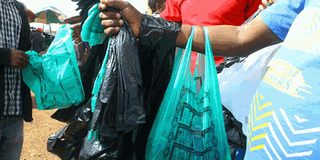It's time to review plastic bag ban

Polythene paper bag vendors at Kisii fresh produce market on April 17, 2017, a week before regulations banning plastic bags use became effective. PHOTO | FILE |NATION MEDIA GROUP
What you need to know:
The greatest failing of the legislation banning plastic bags is that it was not put into a framework of gradual and effective transition to the non-plastic alternatives with the relevant timelines.
The time has come to do a detached professional review of this piece of legislation — where it has succeed and where it has failed.
The concept and motive was sound and, indeed, commendable. The thoroughness of it is questionable with some obvious loopholes arising.
Last August, Kenya imposed a plastic bag ban which at the time was loudly applauded.
Like so many things in Kenya — and around the world — implementation is the key. Whilst there has been implementation, there are loopholes that need to be sealed or solved. The sooner the better as the ban is having an increasingly hollow sound.
But first let’s take a bird’s eye look at the plastic plague. In the past 10 years, the world has produced more plastic than in the last century. One million plastic bags are produced every minute. Half of it is used only once and thrown away. Enough plastic is thrown away each year to circle the earth four times.
CONSUMER BUSINESS
Plastic bags and bottles are made from ethylene, a petroleum-based product. It is cheap to produce, easily available in an assortment of packaging products and, understandably, very convenient in the consumer business. The downside is that a majority of it is not reused, and so lands up as trash. That is where the problem lies.
We are not talking about some soluble item. It becomes litter that is non-biodegradable on land and in water. It just breaks down into smaller particles. It gets ingested by animals and marine life with horrible consequences.
Harmful chemicals in the plastic invade the sea and ground water. They, in turn, become carriers of pollutants. Indeed, there will be more plastic than fish in our seas, lakes and rivers in the next 20 years if the current trend continues.
And, worst of all, there is no effective disposal method. The nearest one gets is by landfilling but that is hardly sustainable and is environmentally unacceptable. So, the plastic bag ban in Kenya was laudable. But whilst their manufacture here has ceased, plastic flat bags come in bulk from Tanzania and Uganda.
EFFECTIVE TRANSITION
As we have seen with the many corruption scams, the system is as porous as a sieve when it comes to transparent and professional implementation, policing and enforcement.
The relevant legal notice says a fine of up to Sh4 million or a prison sentence of two years is applicable if found using an illegal plastic bag. How often has that happened relative to the continued use of plastic bags?
The greatest failing of the legislation banning plastic bags is that it was not put into a framework of gradual and effective transition to the non-plastic alternatives with the relevant timelines.
It is akin to the Energy Regulatory Authority’s regulations on the compulsory use of solar panels. It is totally impractical in the timescales given; furthermore, there is a supply shortfall.
There have also arisen some gray areas. Even the issue of alternatives in use is vexed. One alternative used in many retail outlets is the polypropylene non-woven bag imported from China. Some experts believe it is actually worse than the condemned plastic bag and is made from the same ingredients and, hence, brings the same problems. When it enters water, it contaminates it and releases plastic particles.
DO HOMEWORK
Ironically, it was allowed by the Kenya Bureau of Standards (Kebs). This institution should immediately do its homework and evaluate the dangers it appears to have overlooked. If it is a mistake, the anomaly should be rectified immediately.
What we come back to is encouraging environmentally acceptable alternatives. Sisal is one and, interestingly, Kenya is one of the major producers of sisal in the world. Paper is another, although there are some environmental issues there. Then there is the hardy perennial, the kikapu.
The time has come to do a detached professional review of this piece of legislation — where it has succeed and where it has failed. The concept and motive was sound and, indeed, commendable. The thoroughness of it is questionable with some obvious loopholes arising.
BELLY BUTTON
It would be prudent for the review to be done by a broad group. External professionals and experts should be part of the team, together with representatives from the Environment ministry and Nema. No point of an in-house team examining its own belly button.
It should go further. For example, could the use of alternative packaging be subject to a more favourable tax regime?
Mr Shaw is a public policy and economic analyst. [email protected]





